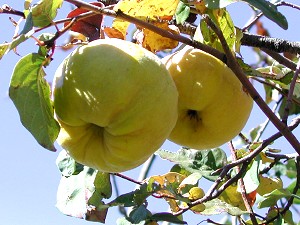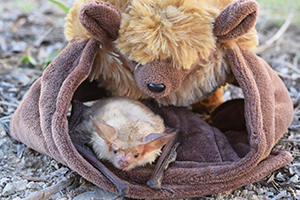The Kino Heritage Fruit Trees Project
Jesús Manuel García-Yánez, Arizona-Sonora Desert Museum & Robert M. Emanuel, University of Arizona
In 2004, two events of profound importance for Spanish Mission Era heritage of the Santa Cruz Valley would come to fruition. First, Tumacácori National Historical Park would acquire additional property that includes the original 5-acre mission orchard and a significant portion of the original agricultural area. And second, construction of Tucson Origins Heritage Park would begin at the foot of Sentinel Peak ("A" Mountain) in Tucson that includes the Mission Gardens, San Agustín Mission Complex and associated orchards.

Quince fruit (called membrillo in Spanish)
The challenge is how to replant these now barren Spanish Mission Era orchards and gardens. Why not use fruit tree stocks (cultivars) that can be traced to those introduced in the late 17th and early 18th centuries by Jesuit missionaries such as Father Eusebio Francisco Kino and/or those introduced in the late 18th and early 19th centuries by Franciscans? Sounds logical, but where to start?
Thus began, in late 2003, the Kino Heritage Fruit Trees Project, the ambitious brainchild of a talented team of researchers of the Arizona-Sonora Desert Museum, University of Arizona, National Park Service, and other Tucson area organizations.
The first task of the project was to identify fruit trees from the Spanish Mission Era (Table). This was accomplished by reviewing father Kino's accounts, 49er documents and journals, and the work of contemporary local ethnobotanists and horticulturalists to trace the legacy of these fruit trees. By some accounts, trees included peach, quince, pear, apple, pecan, walnut, fig, and pomegranate. Together, they made up a portion of the mission community's agricultural livelihood that also depended upon grape vineyards, grain fields, vegetable and pharmacy gardens, as well as livestock.
The fruit trees and other plants identified are either native to the Old World, many originating from the Mediterranean region, as well as a significant number from central and eastern Asia (these are "Old World-exotics"); some are native to North America or southern Mexico, but not endemic to the Sonoran Desert ecoregion (these are "New World-exotics"); while others are native to the Sonoran Desert or Apache Highlands ecoregions.
The goal of the research is to identify stocks, not individual trees. Only a few of the trees (fig, pomegranate, quince) are long-lived (80-100 years), while most live no longer than 20-40 years. So old trees that can be traced back to stocks introduced or assimilated 150-300 years ago are sought. Thus far stocks have been identified in mission orchard communities in Sonora (Mexico), on the campus of the University of Arizona, at Quitobaquito Springs in Organ Pipe Cactus National Monument, historic houses, and in backyards of private residences. Cuttings and seeds are propagated at Native Seeds/SEARCH farm in Patagonia, Desert Survivors nursery in Tucson, Spadefoot nursery in Cochise County, as well as the Arizona-Sonora Desert Museum.
The Kino Heritage Fruit Trees Project researches, locates, propagates and re-establishes historically appropriate fruit tree cultivars to the original orchards and gardens at Tumacácori National Historical Park and Tucson Origins Heritage Park. These reintroductions directly contribute to the interpretive, educational, and preservation objectives of these historic sites.
We can all help on this project, so if anyone has information regarding old stocks of fruit trees in southern Arizona, New Mexico, southern California, or Sonora (Mexico), or would like to know more about this project, please contact Jesús García (phone 520-883-3089, email [email protected]) or Robert Emanuel (phone 520-621-1268, email [email protected]). The National Park Service currently funds this 3-year project.
Thanks to Larry G. Marshall, Jonathan Mabry, Robert Emanuel, and Ann Rasor for providing information on this project.










